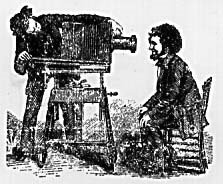Plot
Shutterbug Follies is a story of a young girl who, working at a photo shop, happens upon some photographic evidence of murder. She begins tracking the suspect, despite all odds, becomes determined to solve the crime.
Themes
Feminism is a major theme that runs throughout the story of the little, teenage girl who unveils the evil works of a dangerous man. While she enlists the help of other men to solve the crime, she is always the gutsy one who drags them along.
Another theme is the role of the city as a dangerous place and a blanket for high crime. Also the diversity in the city is commonly depicted throughout the panels.
Art, you could also say is a recurring theme. There is a play on the definition of art, what is accepted as art, and the many forms it can take.
Visual Style
The visual style of this graphic novel is distinct in its use of color, lack of narrative, and the unique panel adaptations from a typical form.
The pictures themselves are very vibrantly colored and styled in a manner typically associated with regular comic books in appearing cartoon-like. They also include little sounds like a comic book would (clack when a phone is slammed down). Furthermore, the entire text appears in dialogue with almost no narrative with the exception of such phrases as "later that day." Where any narrative could exist there are series of pictures demonstrating the progression.
Also, another visual technique employed in this graphic novel is the manipulation of the panels. Certain panels appear through the lenses of binoculars or cameras and others exist as photos or negative film slides.
announcements
This blog was created by and for students in an Introduction to Cultural Studies class at the University of Washington. Through an investigation of urban experience and representation--in theory, in graphic novels and in our own "readings" of Seattle's University District--we considered the formation and history of cultural studies as an (anti)discipline, with a special emphasis on the questions, "What does cultural studies do, and how do you do cultural studies?"
If you'd like to know more about the class, the blog or our U-District artifact project, please contact Gabrielle Dean: gnodean@u.washington.edu.
If you'd like to know more about the class, the blog or our U-District artifact project, please contact Gabrielle Dean: gnodean@u.washington.edu.
Friday, May 9, 2008
Subscribe to:
Post Comments (Atom)
blog archive
-
▼
2008
(92)
-
▼
May
(26)
- Seattle U District: City Artifacts Map
- City Artifacts: What and Where?
- Researching History and its Representations...
- Palestine
- Persepolis 1 & 2
- Shutterbug Follies
- A Scanner Darkly
- Maus I & II
- A Scanner Darkly
- Maus I & II
- Shutterbug Follies
- Persepolis 1 and 2
- Postcards: True Stories that Never Happened
- Maus I & II
- Postcards: True Stories that Never Happened
- Persepolis 1 & 2
- Mail Order Bride
- Mail Order Bride: Mark Kalesniko
- Persepolis 1 & 2
- Shutterbug Follies
- Maus I and II
- Palestine
- Postcards: True Stories That Never Happened
- PALESTINE
- Postcards: True Stores That Never Happened
- Shutterbug Follies
-
▼
May
(26)

No comments:
Post a Comment